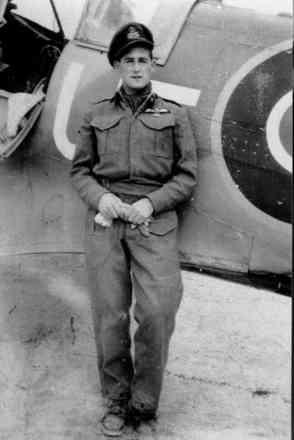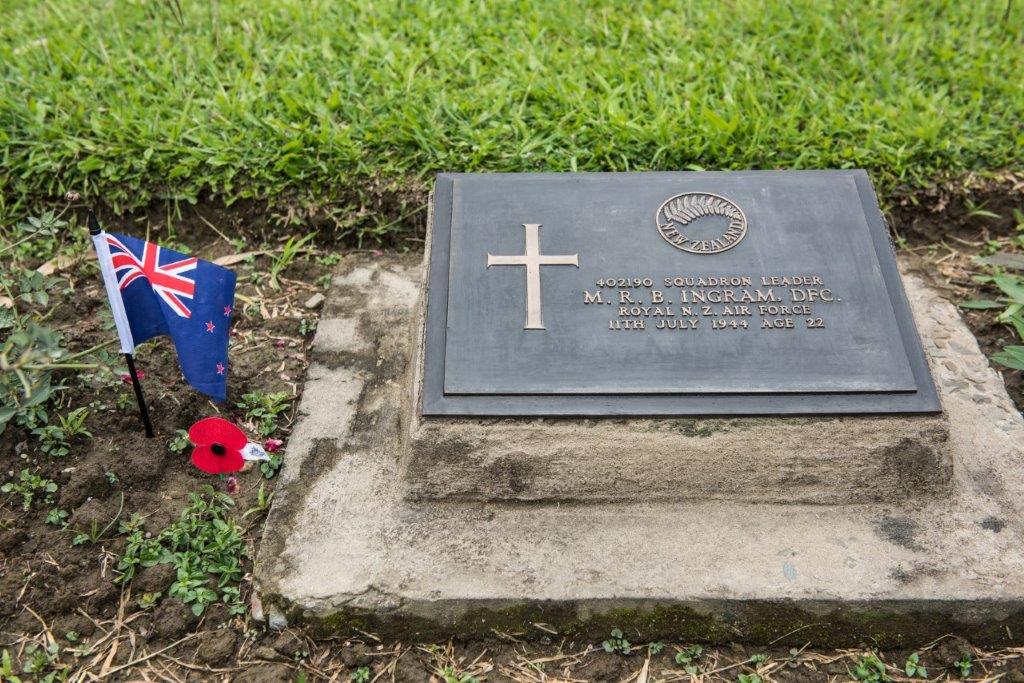Note: I took this from a web page that I failed to document and cannot find again. Apologies to the owner/author for using it without properly asking – hopefully the intent to remember and document is understood.
Acting Squadron Leader Mervin Robert Bruce Ingram.
Son of Charles William Nepean Ingram and of Jemima Moir Webster Ingram (nee Ramage), of Dunedin, Otago, New Zealand.
His log book is in the possession of his family.
The following dossier on Squadron Leader Ingram DFC was supplied by family.
At the age of nineteen Ingram listed in the RNZAF, and in August 1940 was posted to No. 1 EFTS at Taieri, Mosgeil, New ZEaland. Two months later he joined No. 1 FTS at Wigram, Christchurch, where he underwent concentrated training. He left this in February 1941 and in May joined No. 53 OTU, based at Heston, Middlesex, in England.
Training with Spitfires his proficiency as a fighter pilot was rated as ‘average’, and with 525 flying hours experience was posted to 66 Spitfire Squadron, flying Spitfires. Ingram remained here for a month and was then transferred to 611 Aux. Squadron, based at Hornchurch, in mid-July. Flying nearly eighty missions with this Squadron he damaged a ME 109 on 20 September and rose to the rank of P/O in November. On 22 February 1942 he crashlanded his Spitfire, but was ‘exhonerated from all blame’.
Ingram was then posted to No. 486 RNZAF Hurricane Squadron, based at Kirton Lindsey, and on the 20 April 1942 flew with 601 Squadron off the US A/C Carrier ‘Wasp’ to Luqa in Malta. From here action was an occupational hazard and on the 10 May whilst in combat with 16 JU. 87’s Ingram’s cannons jammed, as they also did on his next two sorties. On the 14 May ‘Red and Blue sections’ intercepted 3 JU.88’s with 12 ME.109 escort, at 16,000 feet over the Grand Harbour. Ingram attacked a JU.88 already damaged by F.Lt Barnham, and fired 160 rounds into it. Strikes were observed along the starboard side and the Junkers crashed on the Island.
On 15 June whilst on a long range convoy patrol, Ingram shared in destroying a JU.87 in flames with Sgt. Rowlandson, and a few hours later on a second convoy patrol reported:
‘Convoy picked up about 60 miles W. of Island. At 8,000 feet when about 15 JU.88’s dived on convoy out of sun. Picked one out and followed him through the navy ‘flak’. Fired everything into him and set starboard engine on fire, and large pieces fell off port engine or wing root and E/A crashed near convoy’.
Towards the end of June the Squadron moved to the Middle East where. on the 14 July, the New Zealander, now having the rank of F/Lt., shared in the destruction of a ME.109F with two other pilots at 12,000 feet. A week later six of 601 bounced two ME.109Fs. Ingram selected one and fired four short bursts from 200 yards astern. The E/A was last seen diving steeply through light cloud, ‘right on the deck’. It was credited as confirmed.
Three days later, on the 24th, Ingram intercepted a reconnaissance JU.88 at 25,000 feet off Alexandria harbour, and chased it to the Alamein Line. As the range closed the New Zealander loosed off some long bursts at it. His bursts were accurate and a large piece of the Junkers tail flew back. Moments later the starboard engine burst into flames and the Junkers dived to the ground.
On the 25th after taking off to catch another recco A/C, Ingram reported:
‘Intercepted the E/A at 24,500 feet over base and chased him west to about 10 miles E of foot of Alamein Line. Fired four good long cannon bursts from 400 yards, one large red flash being observed. E/A crashed in our lines.’
During September Ingram flew thirty odd operational flights, scoring four times against ME.109s. He probably destroyed one on the 2nd, damaged one on the 4th, probably destroyed another on the 7th and damaged yet another on the 18th. He was awarded the DFC on the 4 October, having at this time a score of 5 confirmed, 2 probables and 3 damages.
Continuous flying followed and this keen New Zealander scored twice more against 109s in October, claiming a probable whilst escorting Kittyhawks on the 18th, and damaged one of the 25th. On the 31 October he shared with five other pilots in destroying a JU.52, and on the 7 November, whilst patroling the road West of Matruh, against road strafing, he led six pilots to intercept a number of JU.87s with 109 escort. The action was sharpbut favoured the Allied formation, and seven E/A were destroyed without loss, Ingram shooting down a ME.109 and sharing in the destruction of a JU.87 with a fellow pilot.
On the 8 December whilst accompanying Warhawks bombing Marble Arch, Ingram made four attacks, two quarter, two astern, on a ME.102, which went down in a controlled dive, coughing smoke, and force landed behind enemy lines.
In February 1943 he spent a few weeks with the METS at Ballah and was then posted as an instructor to 73 OTU at Abu Sueir, instructing for three months. In late June he joined 232 Squadron at Takali, Malta, and in mid-July was posted to 243 Squadron based at Halfar. On the 3 August again in action he damaged a ME.109 and on the 8th was promoted to Squadron Leader, taking command of 152 Hyderabad Squadron in Sicily. On September 18 in a patrol over ‘Peaches’ beach at 16,000 feet, the New Zealander damaged a F.W.190 and the next day, the 19th, destroyed one, later reporting:
‘Intercepted 9 F.W.190s at about 4000 feet N.E. of base and 190s still bombed up. Fired long burst at one from about 150 yards. Evidently E/A dived in.’
Ingram’s last claim of the war came on the 22 September 1943 when he shared, after expending all his ammunition, with a fellow pilot, in destroying another F.W.190, the pilot of which bailed out. Just before Christmas 1943 the Squadron moved to India, where it flew numerous defensive and offensive patrols, over Allied and enemy held territory. Zeros were known to be about, but the New Zealander never came close enough to test his skill against them. In June 1944, whilst returning from a rhubarb operation Ingram was forced to crash-land short of Imphal, and broke his nose and also received face wounds. Sent to a field hospital, he was taken care of by two nurses, specially flown in, but while there contracted maleria and tetanus, and the combining forces of these diseases, together with injuries sustained in the accident, proved too acute. He died on 11 July 1944.”
Family note that before he was killed his tally of strikes on enemy aircraft had risen to 9.5 confirmed, 3 probables, and 6 damages.
Ingram, at the time of his death, had flown 362 operational trips, totalling approximately 500 operational hours, and was officially credited with 9.5 confirmed victories, 3 probables and 6 damages, all while flying Spitfires.”
Died from injuries received in air crash.
Circumstances of Death: Died of Tetanus and Malaria in Hospital Following Facial Injuries Sustained As A Result of Landing Short After An Operational Sortie


